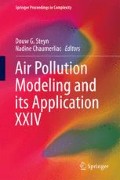Abstract
Volatile Organic Compound (VOC) reactivity scales are used to compare the ozone-forming potentials of various compounds. The comparison allows for substitution of compounds to lessen formation of ozone from paints, solvents, and other products. Current reactivity scales for VOC compounds were first developed using 1-D trajectory/box models for short pollution episodes several decades ago. In this study, they are updated using the 3-D air quality model CMAQ instrumented with DDM-3D. DDM-3D sensitivities are used to update relative reactivity metrics of a number of VOCs over more meaningful timescales. Using sensitivity calculation in the context of an air quality model for reactivity calculations avoids the issues of trajectory assumptions inherent in the 1-D calculations and allow for calculation of regional representative metrics.
Access this chapter
Tax calculation will be finalised at checkout
Purchases are for personal use only
References
Carter WPL (1994) Development of ozone scales for volatile organic compounds. J Air Waste Manage Assoc 44:881–899
Carter WPL (2009) Updated chemical mechanisms for airshed model applications. Report to California air resources board. Contract no. 03-318, 06-408, 07-730
Carter WPL (2010) Development of the SAPRC-07 chemical mechanism. Atmos Environ 44:5324–5335
Hakami A, Harley R, Milford JB, Odman MT, Russell AG (2004) Regional, three-dimensional assessment of the ozone formation potential of organic compounds. Atmos Enivorn 38:121–134
Hutzell WT, Luecken DJ, Appel KW, Carte WPL (2012) Interpreting predictions from the SAPRC07 mechanism based on regional and continental simulations. Atmos Environ 46:417–429
Disclaimer
Although this work has been reviewed and approved for publication by the U.S. Environmental Protection Agency, it does not necessarily reflect the views and policies of the agency.
Author information
Authors and Affiliations
Corresponding author
Editor information
Editors and Affiliations
Questions and Answers
Questions and Answers
Questioner: S. Arunachalam
Question: You mentioned lower formaldehyde reactivity calculated with ddm-based model compared to box-model. Why? What is the mechanism that causes this difference?
Answer: Formaldehyde and other aldehydes are more reactive in box model (resulting in higher reactivity quantifications), because the residence time considered doesn’t allow for carryover of products that continue to be chemically active in the CTM.
Questioner: A. Hakami
Question: How did you prepare your individual VOC emissions?
Answer: VOC emissions for the sensitivity calculations where set to 0.0001 mol/s for each species constant over the entire domain. This was a quantity sufficiently small compared to total VOC emissions to not impact base model ozone concentrations.
Rights and permissions
Copyright information
© 2016 Springer International Publishing Switzerland
About this paper
Cite this paper
Napelenok, S.L., Luecken, D. (2016). Sensitivity-Based VOC Reactivity Calculation. In: Steyn, D., Chaumerliac, N. (eds) Air Pollution Modeling and its Application XXIV. Springer Proceedings in Complexity. Springer, Cham. https://doi.org/10.1007/978-3-319-24478-5_38
Download citation
DOI: https://doi.org/10.1007/978-3-319-24478-5_38
Published:
Publisher Name: Springer, Cham
Print ISBN: 978-3-319-24476-1
Online ISBN: 978-3-319-24478-5
eBook Packages: Earth and Environmental ScienceEarth and Environmental Science (R0)

